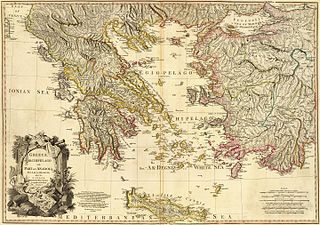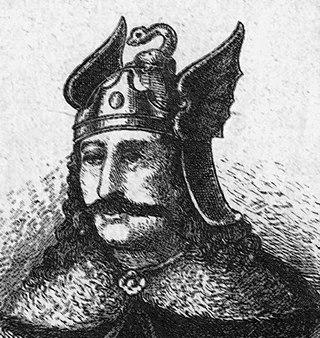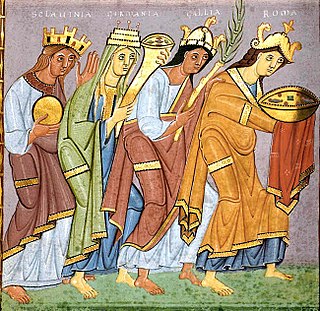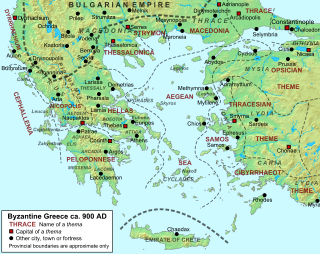
Year 805 (DCCCV) was a common year starting on Wednesday of the Julian calendar, the 805th year of the Common Era (CE) and Anno Domini (AD) designations, the 805th year of the 1st millennium, the 5th year of the 9th century, and the 6th year of the 800s decade.

The Peloponnese, Peloponnesus or Morea is a peninsula and geographic region in Southern Greece, and the southernmost region of the Balkans. It is connected to the central part of the country by the Isthmus of Corinth land bridge which separates the Gulf of Corinth from the Saronic Gulf. From the late Middle Ages until the 19th century, the peninsula was known as the Morea, a name still in colloquial use in its demotic form.

De Administrando Imperio is the Latin title of a Greek-language work written by the 10th-century Eastern Roman Emperor Constantine VII. The Greek title of the work is Πρὸς τὸν ἴδιον υἱὸν αὐτοῦ Ῥωμανὸν. It is a domestic and foreign policy manual for the use of Constantine's son and successor, the Emperor Romanos II. It is a prominent example of Byzantine encyclopaedism.

Asparuh was а ruler of Bulgars in the second half of the 7th century and is credited with the establishment of the First Bulgarian Empire in 681.

Byzantine Greece has a history that mainly coincides with that of the Byzantine Empire itself.

Časlav was Prince of the Serbs from c. 933 until his death in c. 943/960.

The Sclaveni or Sklabenoi were early Slavic tribes that raided, invaded and settled in the Balkans in the Early Middle Ages and eventually became one of the progenitors of modern South Slavs. They were mentioned by early Byzantine chroniclers as barbarians having appeared at the Byzantine borders along with the Antes, another Slavic group. The Sclaveni were differentiated from the Antes and Wends ; however, they were described as kin. Eventually, most South Slavic tribes accepted Byzantine or Frankish suzerainty, and came under their cultural influences and Chalcedonian Christianity. The term was widely used as a general catch-all term until the emergence of separate tribal names by the 10th century.

Vlastimir was the Serbian prince from c. 830 until c. 851. Little is known of his reign. He held Serbia during the growing threat posed by the neighbouring, hitherto peaceful, First Bulgarian Empire, which had expanded significantly toward Serbia.

Zaharija Pribislavljević or Zaharija of Serbia was Prince of the Serbs from 922 to 924. He defeated his cousin Pavle in 922. Zaharija was the son of Pribislav, the eldest son of Mutimir of the first Serbian dynasty.

The Ezeritai were a Slavic tribe that settled in the Peloponnese in southern Greece during the Middle Ages. In the early decades of the 7th century, Slavic tribes (Sclaveni) settled throughout the Balkans following the collapse of the Byzantine Empire's defense of the Danube frontier with some groups reaching as far south as the Peloponnese. The Sclaveni often settled in small groups and their demographic impact in mainland Greece was both weak and diffuse. Of these, two groups are known by name from later sources, the Ezeritai and the Melingoi, both having settled on the slopes of Mount Taygetos.

The Melingoi or Milingoi were a Slavic tribe that settled in the Peloponnese in southern Greece during the Middle Ages. In the early decades of the 7th century, Slavic tribes (Sclaveni) settled throughout the Balkans following the collapse of the Byzantine Empire's defense of the Danube frontier with some groups reaching as far south as the Peloponnese. The Sclaveni often settled in small groups and their demographic impact in mainland Greece was both weak and diffuse. Of these, two groups are known by name from later sources, the Melingoi and the Ezeritai, of whom the Melingoi settled on the western slopes of Mount Taygetos. The origin and etymology of the name Melingoi is unknown.
The Chronicle of Monemvasia is a medieval text of which four versions, all written in medieval Greek, are extant. The author of the account is currently unknown. The Chronicle, specifically the version from the Iberikon monastery, narrates the events that depict the Avaro-Slavic conquest and colonization of mainland Greece, covering a period from 587 to 805 AD. Despite its compelling narrative, the Chronicle is not an actual chronicle. The text represents a compilation of sources involving Avars and Slavs and focuses on the foundation of the metropolitan see of Patras. It is possible that the Chronicle was actually used in negotiations with the metropolitan of Corinth over the status of the metropolitan of Patras.

The Skleros, latinized Sclerus, feminine form Skleraina (Σκλήραινα), Latinized Scleraena, was a noble Byzantine family active mostly in the 9th–11th centuries as members of the military aristocracy, and as civil functionaries thereafter.

The Theme of Dyrrhachium or Dyrrhachion was a Byzantine military-civilian province (theme), covering the Adriatic coast of modern Albania, and some coastal regions of modern Montenegro. It was established in the early 9th century and named after its capital, Dyrrhachium.

The Theme of the Peloponnese was a Byzantine military-civilian province encompassing the Peloponnese peninsula in southern Greece. It was established in c. 800, and its capital was Corinth.

The Theme of Hellas was a Byzantine military-civilian province located in southern Greece. The theme encompassed parts of Central Greece, Thessaly and, until c. 800, the Peloponnese peninsula. It was established in the late 7th century, and survived until the late 11th/12th century, when it was broken up into smaller districts.
Krinites or Krenites Arotras was a Byzantine aristocrat and military governor in southern Greece. He is most notable for suppressing a Slavic revolt in the Peloponnese in 921/22.
Theoktistos Bryennios was a Greek nobleman and a Byzantine general who quelled a Slavic rebellion in the Peloponnese in 842.
The Diocese of Lacedaemon o Lacedaemonia was a Christian ecclesiastical province in Laconia, Greece. Extant from at least the middle of the 5th century, it became a metropolis in 1083. During the period of Frankish rule, between ca. 1209 and 1278, it was held by Roman Catholic prelates, and remains a (vacant) titular see of the Catholic Church. The Greek Orthodox see was restored with the Byzantine reconquest in the 1270s, and continued until the see's abolition in 1852.
John Pitzigaudes, his surname variously also given as Pitzigaudios (Πιτζιγαύδιος), Pitzogabdes (Πιτζογάβδης), and Pittigaudes (Πιττιγαύδης) by different Byzantine chroniclers, was a Byzantine official and envoy.












